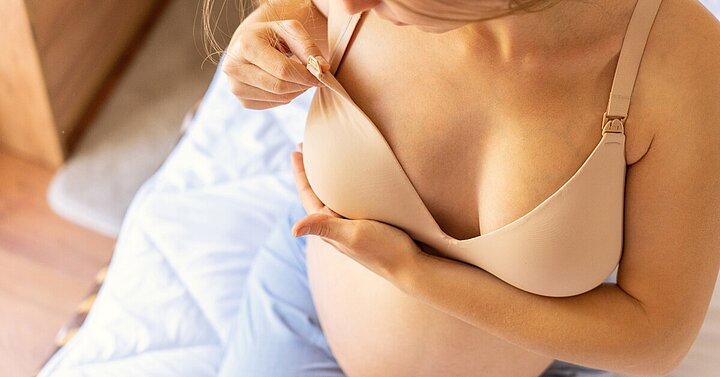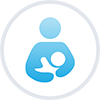Harvesting Colostrum
Feeding | Pregnancy | | Louise Broadbridge
As well as growing a baby, your amazing body is making all sorts of changes in preparation for feeding your new addition once they are finally in your arms. From as early as 16 weeks of pregnancy, your milk production system is already setting the wheels in motion for a smooth transition from nurturing your baby on the inside to continued growth and development on the outside.
The duration of pregnancy varied greatly from woman to woman and all that we can predict is that, under normal circumstances, babies will arrive between 37 and 42 weeks gestation. Nature has been very clever in recognising that having large quantities of milk ready and waiting from 37 weeks could cause some very significant problems for mum should baby not arrive until 42 weeks. Mums would find themselves very sore, very uncomfortable and probably very poorly as their breasts became infected due to being full of unused milk.
Enter Colostrum!
Colostrum is the first stage of breast milk our bodies produce in preparation for the arrival of our baby. Full of white blood cells, this liquid gold helps to guard and fight against infection by producing antibodies that neutralise any bugs your baby may meet in the first few months after birth. Not only that, but colostrum is packed with vitamins and minerals that are great for development of baby’s healthy skin, vision, and immune system.
Because all this goodness is so concentrated, your body can accommodate it for much longer without becoming uncomfortable or unwell. Here are just some of the benefits of colostrum:
- Protects baby against disease
- Packed with nutrients
- Boost baby’s immune system
- Helps to establish a healthy gut
- Assists baby to clear first poo from system
What is Colostrum Harvesting?
In recent years midwives and doctors have started to recognise the benefits of collecting small quantities of this richly packed first milk and storing it for later use. Initially, this practice of hand expressing into little sterile syringes was only recommended for women with diabetes or risk of preterm birth, but it is now widely recognised that it is beneficial for all feeding mums and babies.
You can start colostrum harvesting from 37 weeks, storing your gains in the syringe in a fresh storage bag in the freezer. Here is our step-by-step guide:
- Ask your midwife for some colostrum harvesting syringes or you can purchase them online. You can’t really over collect your colostrum, but we would recommend buying 10 syringes to get you started.
- Chill out. Successful colostrum harvesting relies on a relaxed Mum. Find the right space and time where you won’t be disturbed. Just before bed is perfect.
- Gently massage your breast in a slow but firm action from the top downwards. You can have your hand either in a fist or open.
- Imagine your breast is a clock. With clean hands cup your beast with one hand and make a c-shape with your other hand with your middle finger at around 12 o’clock on the breast and your thumb at 6 o’clock. This should be 2 – 3 cm above the dark area of your nipple.
- Now gently squeeze and release the breast tissue, being careful not to pull the breast.
- Hopefully you will start to see a small amount of fluid leaking from the nipple which you or your partner can draw into the syringe by pulling back on the plunger.
- You may not get anything on your first few attempts but keep trying and don’t be disheartened if you don’t manage to collect anything. It is not an indicator of your future milk supply.
- Once you have collected some colostrum this can be dated and labelled before popping into the freezer for later use.
Why harvest colostrum?
There are lots of benefits for both you and your baby when considering if you should harvest your colostrum. Spending a few minutes each day from 37 weeks harvesting your baby’s first milk can help you become familiar with how your breasts feel and get you used to hand expressing. Learning any new skill can be a little stressful at times and this time will help you to build confidence in your body.
In addition, having a little store of frozen colostrum can be really useful if your baby is a little reluctant to feed or you are struggling with your baby’s latch. Knowing you have some pre-collected milk can really help to relieve your anxiety and also tickle your baby’s taste buds and get them a little more interested.
In addition, as your baby grows you will experience days when your baby feeds much more than usual and you can find yourself questioning if you have enough milk. Having a little bit of colostrum in your freezer can help to ease your anxiety and reassure you that your baby is getting all they need.
Storing colostrum
Keeping your hard-earned gains is really easy. All you need is a clean Tupperware or freezer bag. Once you are ready to freeze your colostrum, pop the syringe back in the sterile packet it came in and put it in your container.
You may not fill up a whole syringe on your first go so you can keep it in the fridge (-2-4 degrees) for up to 48 hours and keep topping it up. Then you can transfer it to the freezer where it can stay safely for up to 6 months.
HiPP mum Emma shares her story: ‘Harvesting colustrum was great for me as my first baby was jaundice and my second had trouble feeding on the first day, so it felt great to know that they were getting all the nutrients they needed. My hospital gave me a bunch of tiny sterile syringes and I had to express. I found after a bath was easiest.’
Faye had a similar experience. “I ended up needing the colostrum I had harvested when my baby wasn’t feeding. A family member brought it into hospital in a cool bag with ice blocks.”


